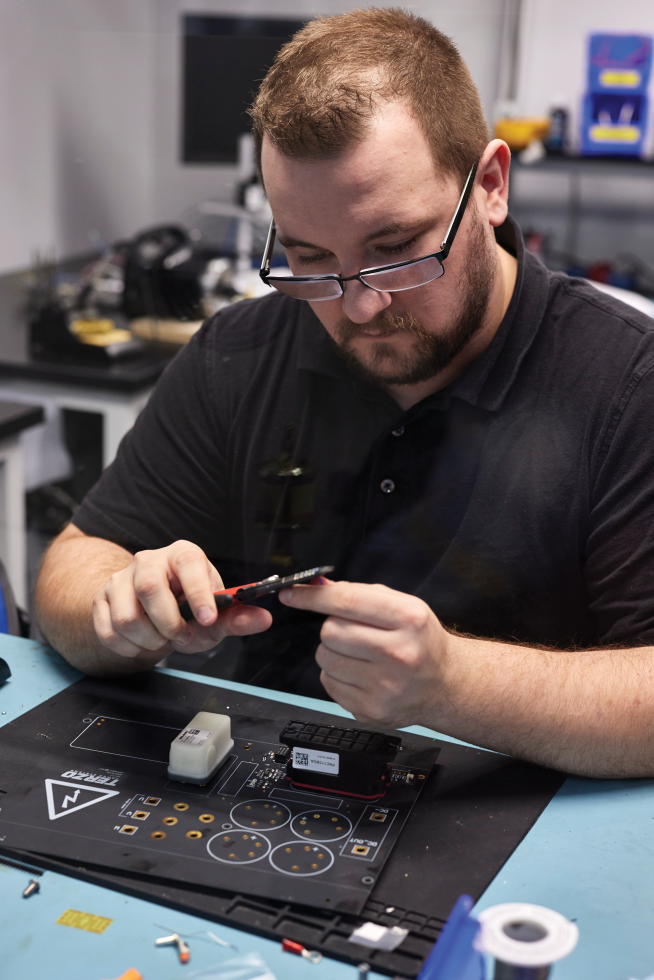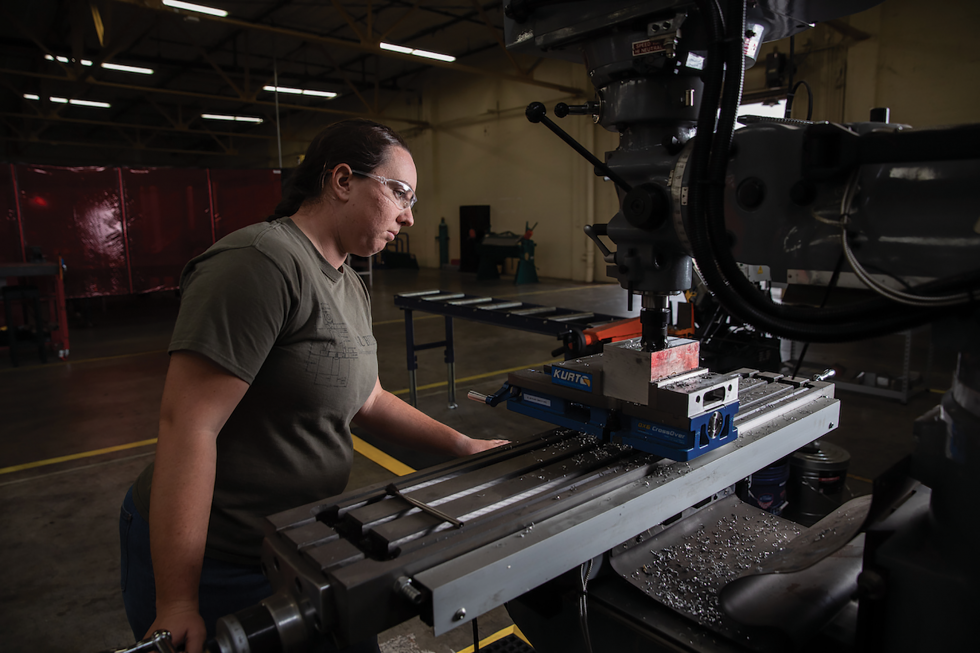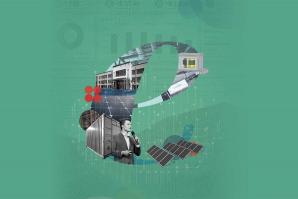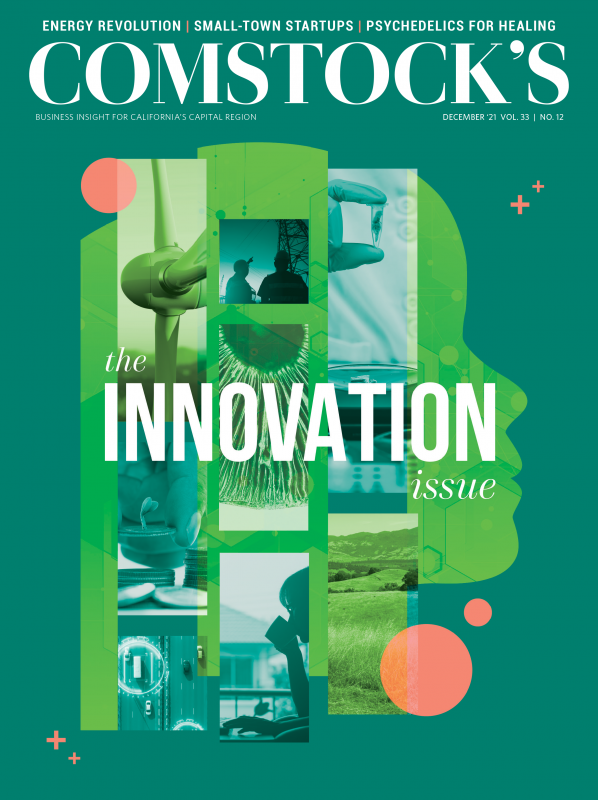Michael Terzo has done the math. By his calculations, the electric hydraulic pump his team of 12 developed at Terzo Power Systems in El Dorado Hills can cumulatively reduce a gigaton of carbon emissions by increasing energy efficiency and reducing oil requirements by up to roughly 75 percent in vehicles and machines that use it. That’s the equivalent of one billion metric tons of carbon dioxide, or twice the mass of all people on Earth.
“I can almost say that every aspect of our life is completely dependent on hydraulics and nobody knows it, which is great. … I’m like a kid in a candy store every day because when else would anybody be able to affect this kind of change globally?” says Terzo, founder and CEO of Terzo Power Systems. Fluid power hydraulics, traditionally powered by petroleum, have broad applications across industrial and manufacturing machines, construction and agricultural equipment, aeronautics and the automotive industry.
Michael Terzo and his team at Terzo Power Systems in El Dorado
Hills developed an electric hydraulic pump that reduces
greenhouse gas emissions from hydraulics, which are traditionally
powered by petroleum. (Photo by Fred Greaves)

Many in those industries have wanted to electrify, Terzo says, but the technology to overcome inefficiency challenges on electric platforms and diverse broad-spectrum applications simply wasn’t in the public domain. While companies like Tesla had already figured out the technology for the automotive industry, Terzo founded his company in 2014 to develop the technology for the off-road vehicle market from scratch.
Today, Terzo Power Systems sells its electric hydraulic pumps to the largest vehicle manufacturers in the world across North America, almost all of Europe, Australia, New Zealand and Japan, with interest from other major players such as India.
Terzo says his electrification technology is one of a handful of things that can affect the level of global emissions reductions he’s calculated. The technology feeds into statewide efforts to electrify mobility and buildings — the two dirtiest sectors — that contribute the majority of California’s carbon emissions, which threaten human health and the planet.
Emissions belched into the atmosphere are linked to a host of respiratory problems and various cancers, and disproportionately impact communities of color. Sacramento County routinely ranks poorly in terms of air pollution by the American Lung Association.
Electrification is the replacement of fossil fuels with electricity generated by clean, renewable sources, and it’s a critical pathway to California’s ambitious goals to achieve carbon neutrality and 100 percent clean energy by 2045. Those are part of the state’s even larger climate goals and those adopted by the majority of the world’s countries in the Paris Agreement of 2015 to keep global warming below 2 degrees Celsius — the level at which the ecosystems that make life possible begin to collapse. But according to the latest assessment by the Intergovernmental Panel on Climate Change, irreversible change is already upon us.
Innovative advancements in clean energy and efficiency, such as Terzo Power Systems’ electrification technology, are reducing emissions while growing the clean economy. These advancements are part of an emerging sector of cutting-edge electrification technology in the Capital Region that includes work being done by the California Mobility Center, local utility providers such as Sacramento Municipal Utility District and Roseville Electric, and homebuilders. Some of those efforts are positioned to serve as models for others on a global scale.
The future of mobility
When it comes to the zero-emission vehicle space, most of it is passenger cars and “that’s a success story in terms of adoption of electric vehicles here in California,” says Mark Rawson, chief operating officer of the California Mobility Center. “We’re the largest EV market in the free world.” And that market is growing.
California aims to reach 5 million zero-emission vehicles on the road by 2030 — approximately one sixth of all registered light-duty vehicles in the state. It’s a giant leap from the state’s total sales of nearly 925,000 electric vehicles as of August 2021, but those are nearly half of all electric vehicles sold in the U.S., according to data from the California Energy Commission. In 2035, those numbers will skyrocket when Gov. Gavin Newsom’s executive order mandating all new passenger cars and trucks sold in California be zero emission goes into effect.
But if the state is going to meet its clean energy goals, Rawson says electrification needs to happen in the medium and heavy-duty on-highway space (think trucks), as well as transit (buses, light rail and trains), and the off-highway space such as construction and agriculture vehicles and equipment — plus the infrastructure to support it all.
Nick Rarick, an electrical engineer, works on building an
electronic power conversion board in a workshop at Terzo Power
Systems in El Dorado Hills. (Photo by Fred Greaves)

That’s the future of mobility. And early-stage companies in these sectors are key clients the CMC is designed to attract and support. Its pioneering collaborative specializes in successful entry into the market, filling a gap accelerators and incubators don’t provide. Clients’ paths to commercialization are supported by an ecosystem of global industry leaders with interests in advanced mobility, such as automobile makers, and companies that provide support services required to overcome commercialization hurdles. Preliminary reports estimate the CMC will bring thousands of jobs and $2.5 billion in economic impact to the greater Sacramento area over the next five years, Rawson says.
The CMC launched its operations in March 2021 at Depot Park in south Sacramento. While the nonprofit is building its client base, it’s already working with clients in the agriculture, construction and mining spaces, and others working on electrified versions of a scooter, a tractor, and a bus, as well as light-duty truck manufacturing and an electric vehicle charging system. While the CMC doesn’t yet have clients in the marine or aviation sectors, Rawson says it’s structured to be able to support them. In fact, the ecosystem is structured to accommodate limitless growth of its client base by expanding its industry leaders and support service providers.
“We built this ecosystem in a way that can scale, but we also want to export this concept and this business model to other countries that want to pursue these types of commercialization collaboratives to help their communities meet their policy objectives around electrification and zero-emission vehicle deployment,” Rawson says. The CMC is in discussions with organizations in Australia, Europe, Canada and Asia Pacific that are interested in replicating its model.
The ecosystem is also designed to enhance working relationships between startups and large industries with completely different cultures. Successfully combining cultures can avoid thwarting success. The goal is to begin to rewrite that interaction and “create a new dynamic where the large incumbents learn how to work with early-stage companies and understand these startups’ constraints and drivers, and vice versa, help clients understand the challenges that large incumbent industries are faced with around their procurement rules and decision-making processes,” Rawson says.
Sacramento State is strategically positioned to support that shift in culture. One of three CMC founding members along with SMUD and UC Davis, Sac State will play a fundamental role in the lifecycle of the CMC. Plans are underway to relocate the CMC and build its permanent facility, called The Hub: Sacramento State Research Park, on the university’s 25-acre Ramona Avenue property, located about half a mile from campus. Phase 1 will include a test track for autonomous and electric vehicles, and an approximately 150,000-square-foot building to house its ramp-up factory, classrooms, offices and a showroom.
Sac State is launching an Office of Clean Energy and Mobility Technology, which will provide all the internships for students at the CMC’s ramp-up factory, providing real world experience for students and faculty, says Jonathan Bowman, vice president of administration and business affairs and chief financial officer for Sac State.
“The goal is that the (clients) then spin off and start up their factor(ies) … in Sacramento. And who are they going to turn to to be their employees but the interns that came from Sac State,” Bowman says. Unlike many universities, the majority of Sac State’s students come from the surrounding area. That drives the university’s focus to serve as an anchor institution that develops and retains talent locally to grow the economy in the Capital Region, he says.
“By seeing that technology before it’s really hitting the market, we may be able to get ahead and create degrees that could really attract students interested in working in the mobility sector.”
Jonathan Bowman, vice president of administration and business affairs and chief financial officer, Sac State
“My dream (for) this in the future is that we’re able to see all these new technologies as they start coming in,” Bowman says. “By seeing that technology before it’s really hitting the market, we may be able to get ahead and create degrees that could really attract students interested in working in the mobility sector.”
And with close proximity to the capitol, Sac State and the CMC have access to the regulators who set California’s legislation around the mobility market, which feeds into national and global markets, further positioning the Capital Region as a hub for clean mobility commercialization.
Electric utilities become key players
While those in the electrification technology space are busy innovating, California’s electric companies have rocketed to the forefront of the mobility and building sectors as key players. To electrify these sectors, California will need to generate, store and distribute roughly three times the amount of energy needed to reach its 2045 climate and clean energy goals. And electric utilities will need to do that while incrementally reducing their dependency on fossil fuels and increasing their portfolio of renewable energy sources. It’s a very tall order.
“(This) essentially is going to turn electric utilities into gas stations,” says David Bradford, electric customer programs supervisor for Roseville Electric, which is owned and operated by the City of Roseville. “That’s a big part of grid modernization. The biggest challenge that we see there is making sure our grid can support the charging and our programs can encourage our customers to charge or behave in a way that works best for the community.”
It’s as complex as a living system — increased capacity, modernized grids, a healthier energy diet, a proactive customer base that can afford the technology, adopts it and uses it, compounded by the need for technology that doesn’t exist or isn’t scalable yet. As the components individually struggle into existence, they may clash, compete and influence one another, but ultimately they must come together for the plan to work. And then it must be defensible.
Electric utilities already face growing threats of cyberattacks, but once the bulk of energy dependence is funneled through them and they increasingly rely on advanced technology to operate, the stakes go up significantly. To ramp up efforts, President Joe Biden launched his 100-day plan to enhance cybersecurity of electric utility control systems and supply chains in April. The plan coordinated efforts with the electricity industry, but according to Security Info Watch, critics say it didn’t include the manufacturers of software and equipment used to operate electric utilities’ control systems. Much of the equipment still used today isn’t designed to counter sophisticated cyberattacks, and members of the electric industry — which are responsible for vetting the software and equipment they use — are calling for more federal guidance.
Sarah Moseley, an intern from Sacramento State, squares aluminum
stock material using a manual mill at the California Mobility
Center ramp-up factory in Depot Park. Photo by Carl
Costas/courtesy of California Mobility Center

SMUD, the sixth largest publicly owned utility in the U.S., plans to boost its clean energy generation from roughly 64 percent in 2020 to 100 percent by 2030, which is 15 years ahead of the state’s goal — as long as rates remain affordable and power remains reliable. Its ambitious Zero Carbon Plan is projected to cost $4.6 billion over the next nine years, which it primarily plans to fund through grants, partnerships and funds from Biden’s $1 trillion infrastructure plan that passed in August 2021, while maintaining its commitment to minimize rate hikes for customers. In fact, affordability is so vital to the plan, if rates aren’t affordable, SMUD may modify or push back its plan until they are. But Lora Anguay, chief zero carbon officer for SMUD, says that’s not the mindset they want to start with.
SMUD plans to expand its clean energy generation, including solar, wind, geothermal and short-duration battery storage, by three and a half times and may expand hydropower using its existing infrastructure — without building new dams or reservoirs. The goal is to be able to then decommission two of SMUD’s natural gas power plants by the end of 2025. That shores up the bulk of its plan.
Renewables, such as solar, wind and hydropower, are the paragons of energy generation, but they have limitations. When the sun doesn’t shine or the wind doesn’t blow, or if there is a drought (like now), renewables don’t generate enough power. Fossil fuels — those like petroleum, natural gas and coal — do. Because they’re reliable, for now. And reliability is key to the way forward.
To cross the finish line of its ambitious goal, SMUD must reconfigure its remaining three power plants. That depends on technologies that aren’t scalable yet. “We’re exploring biofuels and looking at hydrogen or other resources to be able to run through the plants instead of natural gas, and we’re also exploring carbon capture, carbon sequestration. In all honesty, I think that the biofuels get us to the absolute zero,” Anguay says. While biofuels such as ethanol and biodiesel are primarily plant-based and burn cleaner than fossil fuels, their production has its own set of environmental consequences, such as deforestation and the perpetuation of monocultures that reduce biodiversity, compete with food production, and tax water and land resources.
Anguay says SMUD is involved with research and development projects on biofuels, carbon capture technology and long-duration energy storage, in-house as well as in partnership with organizations such as the Electric Power Research Institute in Washington, D.C.
Long-duration energy storage (above four hours) is considered to be a key to the state’s clean energy goals, but it’s still a relatively new technology that isn’t yet scalable for large commercial use. The cost to build the infrastructure and operate the system still outweighs the savings generated by replacing current energy generators such as power plants. While the lithium-ion battery has been the front-running technology for long-duration storage, some believe the goal will be best met with a multitude of options that offer flexibility in terms of cost, efficiencies, technologies and suitability to different regions. The state may be getting closer to that. In October 2020, eight California public energy agencies jointly put out a request for offers for a 10-year contract for long-duration storage technologies. They received bids for 18 different kinds of technology, but without legislative policy to support long-duration storage the investment may be too great of a risk.
SMUD is also partnering with Open Systems International to develop a control system that enables a virtual power plant. Modernized grids will accommodate diverse sources of energy generation rather than energy that is solely produced by electric utilities, and that energy will not only flow out to customers but also from customers back to the grid.
“Our industry hasn’t changed in the last 100 years as much as it has in the last five to 10 years. And so the way our customers are using energy is changing and we need to make sure that our infrastructure, our grid, can support the different manner in which they use energy.”
David Bradford, Electric customer programs supervisor, Roseville Electric
“Our industry hasn’t changed in the last 100 years as much as it has in the last five to 10 years. And so the way our customers are using energy is changing and we need to make sure that our infrastructure, our grid, can support the different manner in which they use energy,” says Bradford, of Roseville Electric. Examples of new ways to use energy may include “power coming back onto the grid from individual sources, like your rooftop,” Bradford says, or an electric vehicle that charges a home. Ford’s all-electric F-150 Lightning truck, coming in spring 2022, can store enough electricity to charge a home for days. Reservations for the truck reached 130,000 as of September 2021.
The City of Roseville is also studying what that future environment of energy use looks like, Bradford says. It’s critical for utilities to understand how to build the appropriate infrastructure and respond in real time to accumulated energy generated by customers that could be stored, used to address an overloaded grid, or even fed back into the larger energy market. That’s what the advanced smart technology control system SMUD is co-developing is designed to do.
As utilities modernize grids to accommodate the growing dependence on electricity, they’re simultaneously promoting incentive-based programs that encourage residential and commercial customers to electrify their vehicles, fleets, buildings and homes, and to invest in supportive infrastructure.
“We’re providing a lot of incentives and all sorts of encouragement and education for our (customers) to take part in this energy revolution and do this together with us,” says Scott Blunk, strategic business planner of electrification and energy efficiency for SMUD. Incentives are vital to advance the clean energy economy. Customer adoption drives market demand, which helps scale the technology and reduce the cost.
But there’s still a lot of work to do. Research presented at the 2019 Behavior, Energy and Climate Change conference in Sacramento showed knowledge of electric appliances is lacking among the majority of consumers, and misconceptions of cost and efficiency remain high. More education is needed among the majority of plumbers and retailers, and some builders too.
But many homebuilders are already making the shift. SMUD and the City of Roseville offer homebuilders in the region up to $5,000 and $4,000, respectively, in incentives per home to build with all-electric appliances: HVACs, clothes dryers, water heaters and induction stove tops that are so advanced in their precision and control when cooking, they leave the beloved gas stove in the dust. And building all electric eliminates the need to install the infrastructure gas requires, which costs about $7,000 per home and is passed on to the homeowner, in addition to maintenance and repairs. “I don’t think most people realize it’s cheaper to operate your building if it was all electric, right? And (it’s) cleaner and safer,” Blunk says.
Sixty-eight of the region’s homebuilders — including some of the nation’s largest such as D.R. Horton, Beazer, KB Homes, Broadway Redux and K Hovnanian — are enrolled in SMUD’s All-Electric Smart Homes program, and have completed 517 single-family homes and 20 multifamily homes as of September 2021, with plans for 3,004 more to be completed by 2024 in SMUD’s service area. The City of Roseville launched its homebuilders’ incentive program in spring 2021. Within hours of launching, D.R. Horton enrolled in the program and has built and sold more than 25 all-electric homes in Roseville with more than 250 planned for development as of September 2021.
Early adopters may have a leg up in the market as new legislation nudges building codes toward all electric beginning Jan. 1, 2023. In August 2021, the California Energy Commission updated its energy code encouraging an electric heat pump for space or water heating in most new homes and buildings statewide and all-electric-ready infrastructure for single-family homes. Blunk says it’s estimated that requirement will drive the majority of builders to opt out of gas altogether, catapulting roughly 80 percent of all new construction to all electric beginning in 2023. And the City of Sacramento adopted its New Building Electrification Ordinance in April 2021 with stricter measures than the state. The city’s new code requires all-electric builds for one- to three-story buildings beginning Jan. 1, 2023, followed by buildings with four or more stories on Jan. 1, 2026, and it’s considering requirements to retrofit existing buildings.
But the new code has met strong opposition from local industries such as restaurants and manufacturers that consider fossil fuels paramount to their business. In fact, the California Restaurant Association filed suit against the City of Berkeley for enforcing a similar ordinance. But it looks like gas appliances are headed the way of the dodo bird, as more than 50 cities and counties in California have committed to all-electric construction.
“When we started this three years ago, electrifying buildings was not really spoken of as something that we were going to be doing in the future, and it’s really come on strong,” Blunk says. “So the people who are in our program now were more aware of where society is going … and they saw this as an opportunity to learn before it gets mandated … and get ahead of the curve.”
It’s that innovative ethos that will drive the progress that collectively may save the planet. If we don’t innovate, we can’t address the goals, Terzo says. “It’s that sense of urgency of waking up every day and (asking), what are you gonna spend your finite amount of time on?”
–
Stay up to date on business in the Capital Region: Subscribe to the Comstock’s newsletter today.
Recommended For You

Show Me the Money
Automation and ag-tech help fuel Capital Region’s funding boost
As the pandemic shifts the landscape of investing in
the Capital Region, so too are the dynamics between tech startups
and investors.

Startup of the Month: INN>CHRG
Yolo County-based startup aims to eliminate range anxiety for electric vehicle drivers
INN>CHRG is developing an app that allows any private property (residential, business, etc.) with electricity to potentially become a charging location.

Power Surge
The Capital Region is emerging as a clean energy technology hub
Here are four innovative companies helping drive the clean energy
revolution in the region.

The Transportation Revolution
How we get around is rapidly evolving, and more change is coming
Several public and private sector partnerships are helping to position the Capital Region as a leader in the new mobility revolution.
Part of this month’s Innovation issue




